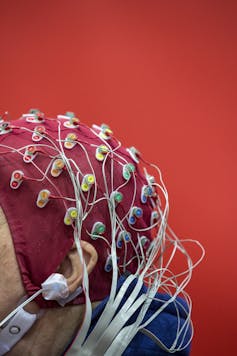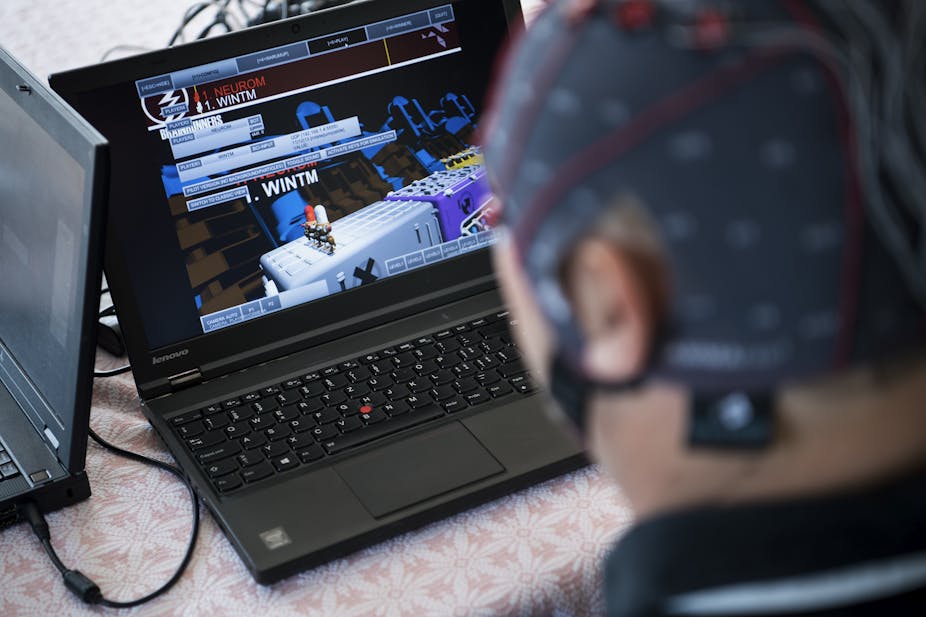The arena vibrates with the enthusiasm of the spectators and the nerves of competitors. The first-ever Cybathlon is about to begin – and both the sold-out audience of 4,600 and teams are justifiably excited.
The Cybathlon is the world’s first athletics event where the competitors are those living with severe disabilities such as paralysis or the loss of limbs, supported by cutting-edge assistive technology such as prosthetics and implants developed by university research teams. The Cybathlon, which has just taken place, aims to harness competition to spur on the technology that could offer huge improvements to millions of people’s lives.
The event’s six disciplines are based on the competitors’ physical needs, including agility courses for those with bionic arms and legs, obstacle courses including flights of stairs for wearable exoskeletons, powered wheelchair races, and a bike race for paralysed competitors using electronic muscle stimulation to move their legs.
BrainStormers, our team from the University of Essex Brain-Computer Interface and Neural Engineering Lab, competed in the final category: a videogame challenge played by paralysed parathletes using a brain-computer interface.
Our technology captures signals through an EEG cap worn by David Rose, our pilot, who has been paralysed from the shoulders down for 29 years. Our system must correctly interpret his thoughts into four different commands, jump, roll, run or wait, which must be sent at 16 different platforms in the game in order for the videogame avatar to progress. To issue any of the commands, the pilot has to conjure up a different thought: for example, to “jump” David thinks of moving his feet, while “roll” corresponds to imagining a phone ringing. The pilot must conjure the thought corresponding to the required command quickly to enable the system to interpret it quickly and accurately in order to move the avatar faster than the other teams and win.
Brain-powered racing
On the day, we collect brain signal test data but unfortunately the signals are noisy, so the algorithms that interpret David’s thoughts will not work as well as in the lab. This is something we’d anticipated – EEG signals are very weak – so we developed a system that could mask the interference in order to extract the information we need. In the minutes before the race David is “in the zone”: he meditates to help his muscle spasms and keep calm, which might give us the edge we need to win. We check the commands are being transmitted to the Cybathlon game system, then the countdown and the game begins.
While David is fully focused on the game, team member Davide Valeriani and I follow his progress on the screen as he quickly moves into first position. Even with the noise from the audience, we can still hear David’s wife Hilary cheering over them. I secretly hope that this doesn’t distract David from the race – it doesn’t, and we finish first in our heat with a time of 146 seconds.

The final race of the qualifying heats is incredible: Eric Anselmo, pilot for the Brain Tweakers from EPFL in Lausanne, Switzerland, finishes in less than 100 seconds, pushing our team into fourth place. Tense, we watch as the second team’s pilot approaches the finish line, keeping a nervous eye on the clock as it approaches our team’s time. As 146 seconds passes, we are overcome with excitement, nerves, elation – and the pressure of knowing we will be in the final (by just two seconds).
In the final race, David competes against two pilots from EPFL and the pilot from BrainGain, a team from the Netherlands. David had seemed tranquil until now, but starts to get nervous. We train in our booth, but the external interference and the team’s excitement make it difficult to make much sense of the EEG signals. Worse, the interpreter has switched the “jump” and “run” commands, adding confusion to he task David faces.
The race starts and it’s nerve-racking, but now it all depends on how David can adapt his thoughts during the race. The four avatars start at the same pace, with all pilots making similar mistakes. But one of the Brain Tweakers’ pilots takes the lead, with David and the BrainGain pilot neck and neck. The last platform seems to stretch on eternally as we watch, clutching each others’ arms and mentally conjuring “run!” in our heads.
In the end, BrainGain gets the edge with a five-second lead, leaving BrainStormers to take the bronze medal in third. But the effort of working towards the Cybathlon has paid off – at that moment, we’re the happiest team on Earth. A group of students who volunteered their time and efforts towards the project, we considered ourselves the underdogs – and reached the podium. We couldn’t have asked for more.

Forward to the future
Our pilot David took some time to process his achievement. Formerly a wheelchair rugby player for the GB team he was visibly emotional – he’d never won a medal, he said. For David, what Cybathlon has achieved is to push the limits of what technology can achieve when put to practical use outside the lab. Throughout the two years I’ve worked with him, David has always been very enthusiastic about the possibilities of brain-computer interface technology to improve the lives of people with disabilities like his – to open doors and windows, for example.

Some of the events saw the audience leave visibly emotional by what they’d seen – particularly the exoskeleton course, where a competitor who has been wheelchair-bound for years tackles a flight of steps. So I believe Cybathlon has fulfilled its goal of bringing home the difficulties of everyday life for the disabled, and to remind us to focus on how technology can help. The brain-computer interfaces developed for the race are easily adapted to control a wheelchair, for example, and I hope research teams bear these practical uses in mind rather than striving to build perfect systems that work only in lab conditions. The emphasis must be on usability and on bringing together technology providers and users – and that’s what Cybathlon has achieved.
Two years ago it proved difficult to find a pilot to take part in the event. Now I receive many emails from families of people with disabilities asking if I can help them. Talks are underway to organise the next Cybathlon alongside the 2020 Olympic and the Paralympic games in Tokyo. Despite the technological and psychological challenges, the event has shown the world – and the disabled competitors themselves – what it’s possible to achieve even while the world watches you think.

